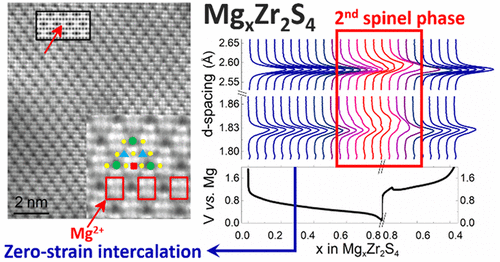当前位置:
X-MOL 学术
›
Chem. Mater.
›
论文详情
Our official English website, www.x-mol.net, welcomes your
feedback! (Note: you will need to create a separate account there.)
Insights into Mg2+ Intercalation in a Zero-Strain Material: Thiospinel MgxZr2S4
Chemistry of Materials ( IF 7.2 ) Pub Date : 2018-06-22 00:00:00 , DOI: 10.1021/acs.chemmater.8b01345 Patrick Bonnick 1 , Lauren Blanc 1 , Shahrzad Hosseini Vajargah 1 , Chang-Wook Lee 2 , Xiaoqi Sun 1 , Mahalingam Balasubramanian 2 , Linda F. Nazar 1
Chemistry of Materials ( IF 7.2 ) Pub Date : 2018-06-22 00:00:00 , DOI: 10.1021/acs.chemmater.8b01345 Patrick Bonnick 1 , Lauren Blanc 1 , Shahrzad Hosseini Vajargah 1 , Chang-Wook Lee 2 , Xiaoqi Sun 1 , Mahalingam Balasubramanian 2 , Linda F. Nazar 1
Affiliation

|
The Mg battery cathode material, thiospinel MgxZr2S4 (0 ≤ x ≤ 1), exhibits negligible volume change (ca. 0.05%) during electrochemical cycling, providing valuable insight into the limiting factors in divalent cation intercalation. Rietveld refinement of XRD data for MgxZr2S4 electrodes at various states of charge, , coupled with EDX analysis, demonstrates that Mg2+ can be inserted into Zr2S4 at 60 °C up to x = 0.7 at a C/10 rate (up to x = 0.9 at very slow rates) and cycled with a high Coulombic efficiency of 99.75%. HAADF-STEM studies provide clear visual evidence of Mg-ion occupation in the lattice, whereas XAS studies show that Zr4+ was reduced upon Mg2+ intercalation. Operando and synchrotron XRD studies reveal the creation of two phases during the latter stages of discharge (x > 0.5) as the lattice fills and Mg2+ ions begin occupying tetrahedral (8a) sites in addition to octahedral (16c) interstitial sites. Compared to the isostructural Ti2S4 thiospinel, Zr2S4 presents a slightly larger cell volume and hence an almost ideal zero-strain lattice on Mg2+ insertion. Nonetheless, its 4-fold lower electronic conductivity results in a diffusion coefficient for Mg2+ ions (DMg; 1 × 10–10 to 1 × 10–9 cm2/s) that is more than a factor of 10 lower than in Ti2S4. This shows that delocalization of the electron charge carriers in the framework is a very important factor in governing multivalent ion diffusivity in the thiospinel framework and, by extension, in other materials.
中文翻译:

零应变材料中Mg 2+嵌入的洞察力:硫喷松Mg x Zr 2 S 4
镁电池的正极材料,thiospinel的Mg X的Zr 2小号4(0≤ X ≤1),显示出在电化学循环期间可忽略不计的体积变化(约0.05%),提供有价值的洞察二价阳离子嵌入的限制因素。对Mg x Zr 2 S 4电极在不同电荷状态下的XRD数据进行Rietveld精修,结合EDX分析,表明Mg 2+可以在60°C的情况下插入Zr 2 S 4,直到在C时x = 0.7 / 10率(最高x= 0.9(非常慢的速度)并以99.75%的高库仑效率循环。HAADF-STEM研究提供了镁离子在晶格中占据的清晰视觉证据,而XAS研究表明,随着Mg 2+的插入,Zr 4+会减少。Operando和同步加速器XRD研究表明,在放电的后期阶段(x > 0.5)产生了两个相,这是因为晶格填充和Mg 2+离子开始占据八面体(16c)间隙位置之外的四面体(8a)位置。与同构Ti 2 S 4硫代松油相比,Zr 2 S 4呈现出稍大的晶胞体积,因此在Mg 2+插入时几乎理想的零应变晶格。但是,其低4倍的电导率导致Mg 2+离子的扩散系数(D Mg; 1×10 –10到1×10 –9 cm 2 / s),比Mg 2+离子的扩散系数低10倍以上。 Ti 2 S 4。这表明在框架中电子载流子的离域化是控制硫代松油框架中以及进而扩展到其他材料中的多价离子扩散性的一个非常重要的因素。
更新日期:2018-06-22
中文翻译:

零应变材料中Mg 2+嵌入的洞察力:硫喷松Mg x Zr 2 S 4
镁电池的正极材料,thiospinel的Mg X的Zr 2小号4(0≤ X ≤1),显示出在电化学循环期间可忽略不计的体积变化(约0.05%),提供有价值的洞察二价阳离子嵌入的限制因素。对Mg x Zr 2 S 4电极在不同电荷状态下的XRD数据进行Rietveld精修,结合EDX分析,表明Mg 2+可以在60°C的情况下插入Zr 2 S 4,直到在C时x = 0.7 / 10率(最高x= 0.9(非常慢的速度)并以99.75%的高库仑效率循环。HAADF-STEM研究提供了镁离子在晶格中占据的清晰视觉证据,而XAS研究表明,随着Mg 2+的插入,Zr 4+会减少。Operando和同步加速器XRD研究表明,在放电的后期阶段(x > 0.5)产生了两个相,这是因为晶格填充和Mg 2+离子开始占据八面体(16c)间隙位置之外的四面体(8a)位置。与同构Ti 2 S 4硫代松油相比,Zr 2 S 4呈现出稍大的晶胞体积,因此在Mg 2+插入时几乎理想的零应变晶格。但是,其低4倍的电导率导致Mg 2+离子的扩散系数(D Mg; 1×10 –10到1×10 –9 cm 2 / s),比Mg 2+离子的扩散系数低10倍以上。 Ti 2 S 4。这表明在框架中电子载流子的离域化是控制硫代松油框架中以及进而扩展到其他材料中的多价离子扩散性的一个非常重要的因素。











































 京公网安备 11010802027423号
京公网安备 11010802027423号